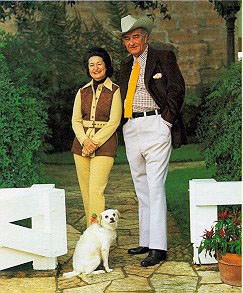
NPS/Ron Sprouse All the world is welcome here.

STRUCTURAL HISTORY The original section of the home was built out of the native limestone fieldstone by a German immigrant, William "Polecat" Meier in 1894. In 1909 the President's aunt and uncle, Frank and Clarence Martin, bought the house and added the main central portion of the home. The Johnson's bought the home from Lyndon's aunt in 1951. The house needed considerable shoring up, and the Johnsons made a number of additions, most notably the master bedrooms and the office wing. HEART'S HOME The Texas White House was an important place to President Johnson as president and as a child. Here are some of his memories: "I first came to this house as a very young boy. This is the big house on the river. My uncle and aunt lived here. They would always ask all the in-laws to come here and spend their Christmas. Frequently, I would come here during the summer when Judge Martin, my uncle, lived here and I'd spend three months' vacation from school riding with him and looking after the cattle. I kept coming back to this house. I guess I must have had a yearning to some day own it. But when we came here on one of the periodic visits in 1952, my aunt told me that she was in advancing years and poor health and she wondered if I wouldn't buy the place. And I did." 
LAWN CHAIR STAFF MEETINGS Mrs. Johnson recalls: "It was always Lyndon's favorite time, particularly around sunset, from the earliest spring until cold weather drove us in. And we have lots of interesting pictures in this front yard. I remember Adlai Stevenson, and the Speaker, Mr. Rayburn and Lyndon. And indeed, I remember President Truman's visit. I think he was here at least twice. Once was for the barbecue that we had for President Lopez-Mateos of Mexico down there in the grove on the river. He would have a long table and we have lots of pictures of the Chiefs of Staff, and Bob McNamara and MacGeorge Bundy, Lyndon all sitting out here doing business and General Westmoreland and various other people. And December was always the month of the budget. Whoever was in charge of the budget, they would come and stay days and days and they would work night and day. And even in December, there are mild days and frequently a part of that would be here. And the Washington shuttle, as we laughingly called it, a plane from Washington that would come down bringing a secretary of whatever department, McNamara of Defense or Freeman of Agriculture or Udall of Interior, to speak his piece for the needs of his particular department and, therefore, a lot of the work followed him." Lyndon Johnson was educated at a relatively small school called Southwest Teacher's college in San Marcos, and he sometimes felt insecure about his education around the Ivy-leaguers and intellectuals that he dealt with in Washington. He liked to have his staff meetings under the stately live oak in the front yard of the ranch house and discuss the issues of the day ranging from the Vietnam War and Civil Rights to new grasses for the ranch. Many of his advisors were unfamiliar with Texas ranches and would have to defer to the President on these issues. Here on his home turf he had what sports fan call the "home field advantage". He was more confident in persuading or twisting arms. 
HANGAR Behind the Texas White House is the hangar and the airstrip. The Johnsons had these constructed soon after buying the LBJ Ranch. While in office, President Johnson's large Air Force One was a jumbo jet called a 707. It never landed at the ranch because it was too heavy for the runway. The President would fly from Washington aboard the 707 to either San Antonio or Austin and then make the short hop to the ranch, usually by helicopter or car. President Johnson had smaller jets called Jetstars that could fly directly from Washington to the ranch. |
Last updated: December 23, 2024
